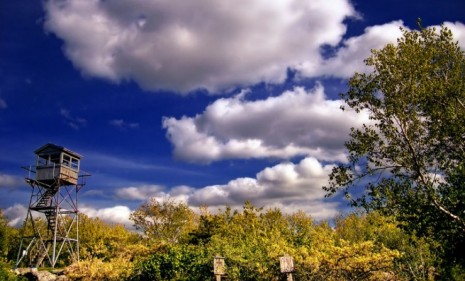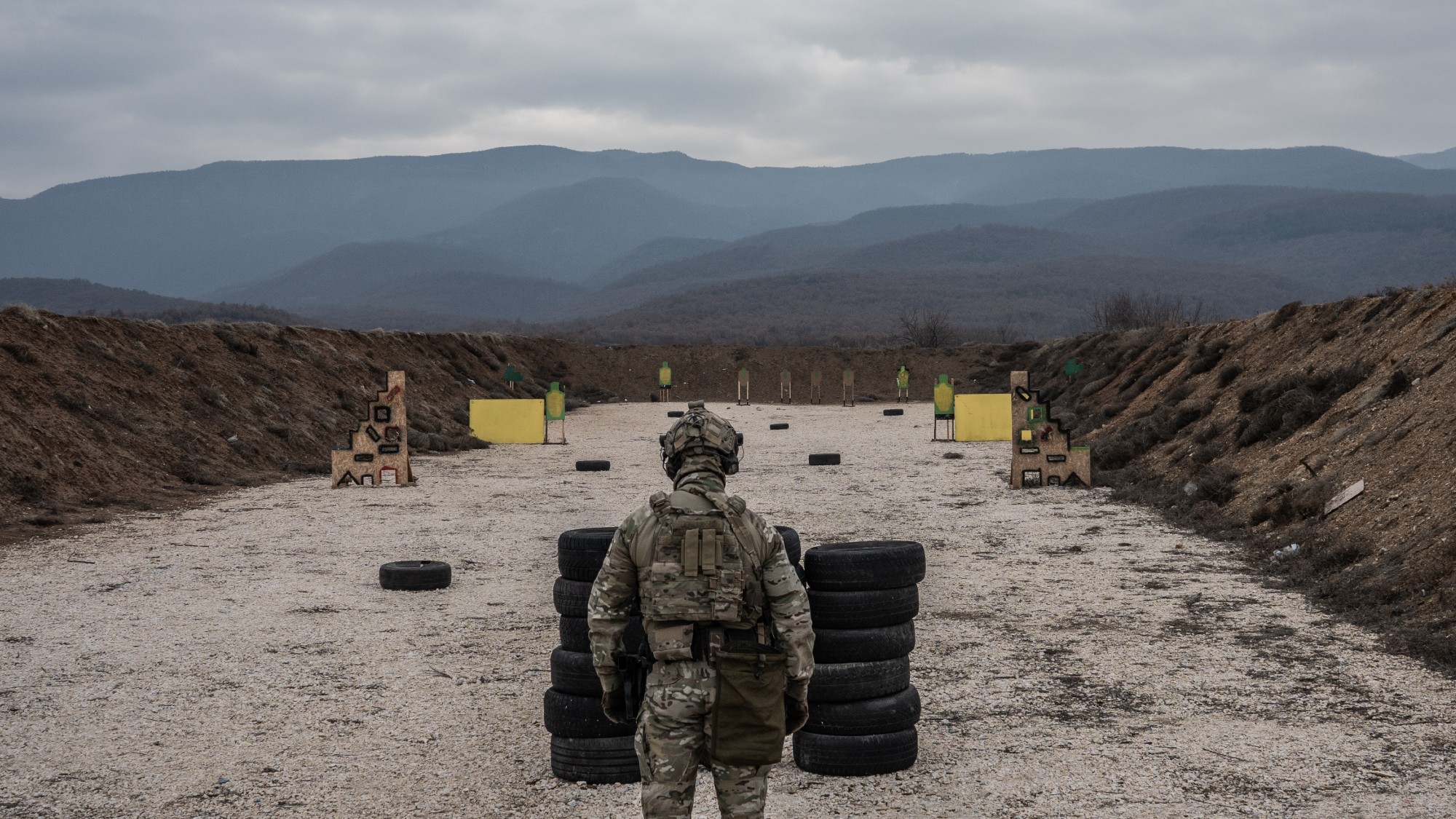The first curl of smoke
Searching for fires from a tower in a vast, isolated wilderness, says Philip Connors, is the best job on earth

UNTIL ABOUT 15 years ago, I thought fire lookouts had gone the way of itinerant cowboys, small-time gold prospectors, and other icons of an older, wilder West. Then a friend of mine named Mandijane asked for my mailing address. M.J. said she’d soon have a lot of time to write letters. When spring exams were over, she’d be off to New Mexico to watch for fires.
I was intrigued, and more than a little envious; M.J.’s letters did not disappoint. She was posted in the middle of the Gila National Forest, on the edge of the world’s first designated wilderness, 130 miles north of the border with Mexico. On Loco Mountain, she said, not a single man-made light could be seen after dark. She lived in her lookout tower, a 12-by-12-foot room on stilts. The nearest grocery store was five miles by pack trail and 85 more by mountain road. The romance in those letters was almost unimaginable.
One spring she wrote to say she was taking another summer gig in the Gila, this time at a different tower, 40 miles southeast of Loco Mountain. She knew I was busy, tied to a desk in New York, but suggested I take a vacation and come see the country, for a few days at least.
The Week
Escape your echo chamber. Get the facts behind the news, plus analysis from multiple perspectives.

Sign up for The Week's Free Newsletters
From our morning news briefing to a weekly Good News Newsletter, get the best of The Week delivered directly to your inbox.
From our morning news briefing to a weekly Good News Newsletter, get the best of The Week delivered directly to your inbox.
I needed no further urging. I’d already hustled too long and for no good purpose in the city, and when I finally looked out on that country with two dozen mountain ranges I couldn’t name, more mountains than a person could hope to explore on foot in a lifetime, I guess you could say I fell in love at first sight.
And what a sight it was: a stretch of country larger than the state of Maryland, nearly 20,000 square miles of desert and forest, sky island mountain chains in three states and two countries. In the afternoons, when M.J. sat in the tower keeping watch, I hiked through old-growth fir and massive groves of quaking aspen. I was unaware of it at the time, but those aspen had grown back in the scar of what was, for almost half a century, the biggest fire on record in the Southwest: the McKnight Fire of 1951, which burned 50,000 acres along the slopes of the Black Range.
Around our own little bonfire under starlight, M.J. told me she’d grown antsy in the lookout. She wanted to get out on a fire, inhale the smoke, feel the heat of the flames—and make some bigger money, overtime and hazard pay. Her boss was game, she said, if she could find him someone reliable to take over fire watch. By the time I had to hike out and head home, I’d talked myself into her job. I knew almost nothing about being a lookout except what I’d read in books, but what I’d read seemed promising. “It doesn’t take much in the way of body and mind to be a lookout,” Norman Maclean had written. “It’s mostly soul.”
SINCE THAT FIRST summer, I’ve returned each succeeding year to sit 10,000 feet above sea level and watch for smoke. Most days I can see a hundred miles in all directions. On clear days I can make out mountains 180 miles away. To the east stretches the valley of the Rio Grande, cradled by the desert: austere, forbidding, dotted with creosote shrubs, and home to a collection of horned and thorned species evolved to live in a land of scarce water.
A free daily email with the biggest news stories of the day – and the best features from TheWeek.com
To the north and south, along the Black Range, a line of peaks rises and falls in timbered waves; to the west, the Rio Mimbres meanders out of the mountains, its lower valley verdant with grasses. Beyond it rise more mesas and mountains: the Diablos, the Jerkies, the Mogollons. A peaceable kingdom, a wilderness in good working order—and my job to sound the alarm if it burns. Between five and 15 times a year, I’m the first to see smoke.
Having spent eight summers in my little glass-walled perch, I have an intimate acquaintance with the look and feel of the border highlands each week of each month, from April through August. I’ve seen lunar eclipses and desert sandstorms and lightning that made my hair stand on end. I’ve seen fires burn so hot they made their own weather. I’ve watched deer and elk frolic in the meadow below me and pine trees explode in a blue ball of smoke.
If there’s a better job anywhere on the planet, I’d like to know what it is.
ON THE LAST Monday of April, I hike in for the start of another tour, smelling along the way the sweet dry scent of pine needles in sunlight, my dog Alice 50 yards ahead of me, both of us loafing along, finding our rhythm—no reason to rush on such a fine spring day, a beautiful morning in the Black Range for April, unusually calm.
We’re a mile up the trail from the saddle, just crossing a short ridge connecting two hills, when I see a globule of smoke curl out of a canyon bottom, a mile northeast and a thousand feet below.
Fire.
The absence of an up-canyon haze of drift smoke indicates the fire has just popped up. The color and the shape of the smoke tell me still other things, so by the time I drop my pack and key up my radio—Alice looking at me curiously, her head cocked to one side—I’m pretty certain I’m the only person on earth who can see it.
My initial reaction to the sight of smoke remains unchanged over the years. It’s always a major kick. I take a couple of minutes to regulate my breathing and douse my sizzling nerve ends in the cold water of government professionalism before I press the transmit button on the radio. Otherwise I’d sound as if I were the thing on fire.
If you threw a hundred darts at a map of the Black Range, you’d be hard-pressed to hit a spot more conducive to an unwanted fire. Brushy fuels cover steep slopes at the confluence of three drainages, offering the fire ample combustibles and plenty of avenues to move. Fire has been ruthlessly suppressed in the surrounding country for a hundred years, so fuel loads are very high. The rough terrain makes the area too dangerous to work with a helicopter, removing one tool from the suppression arsenal. The proximity of Embree, less than two miles east, adds private homes to the list of concerns.
With firefighters coming from between 40 and 120 miles away—no smokejumpers available in the Southwest just yet—I arrive on the peak about the same time the first crew of five reaches the fire. An airplane observer is up and circling, talking to the crew on the air-to-ground frequency. From the tower, I’m just able to see the top of the smoke rising above a ridge.
At a little past noon, the crew returns its verdict on the source of the fire: an abandoned campfire. Perhaps a couple of weekend turkey hunters broke camp hurriedly, confident a stone ring would hold their fire’s embers in check. No such luck, not this time.
In the weather we’ve had lately—warm and windy, following on a dry winter—a pit of ash over coals can smolder for a couple of days, heating the surrounding earth until the pine duff around the stone circle ignites.
At 12:40 Tony, the incident commander (IC), calls his size-up in to dispatch. The fire is 10 to 12 acres now, burning in grass and piñon-juniper, smoldering and making isolated runs, with flame lengths of two to three feet. Winds are light and variable, gusting to seven. Potential for spread is high.
Tony requests a heavy tanker for slurry drops and a second hot-shot crew in addition to the one already on order. After signing off with dispatch, Tony dials up his crew on one of the tactical channels I’ve reset my radio to scan, in order to eavesdrop. “Jimbo’s gonna mark off the fire’s origin with some flagging tape. Make sure you’ve got plenty of water. I’ve got reinforcements coming. We’re gonna need everybody to be heavy hitters on this one.”
By mid afternoon 70 pairs of boots are on the ground—three hot-shot crews and two engine crews—working furiously with chain saws, Pulaskis, shovels, and rakes to cut and dig a containment line down to mineral soil along the fire’s flanks, denuding the land of all vegetation. The goal is to halt the fire’s spread by starving it of fuel, keeping it inside the line.
The observer plane circles overhead, giving the IC updates on the fire’s behavior. Guided on its drops by another aircraft called a lead plane, the tanker makes runs with slurry over the ridge tops, hoping to hold the head of the fire in check long enough for the ground crews to bring their lines along both flanks. Every now and then a stand of thick timber torches, and a dark gray cloud of smoke rises into the sky.
Around 4 o’clock the fire crosses the main creek bottom and begins to burn up the other side. The IC admits to the observer plane that despite their suppression efforts they may not catch this one. “Don’t know what to recommend to you,” the spotter replies. “You’re doing all the right things, but it’s kind of a dog’s breakfast down there.”
The IC calls me next. We know each other well, Tony and I. He’s my boss’s second-in-command, has been on the Gila five years. No need to mince words. We both know the score: If the fire continues to the top of the ridge on the north, it will eventually find continuous brush and heavy timber for miles to the west, including all the way to the top of my peak.
“Phil, have you got your safety zones planned out?” Tony asks.
“I’ve got options. The meadow is big and open and mostly grass. There’s also a little boulder field where the deer have munched away all the vegetation. And of course there’s always the cistern. I could drop down in there and tread water for a couple hours if it came to that.”
“Well, we’d try to fly you out by chopper before then. But just think ahead a little for me. Safety’s absolutely number one.”
“Copy that,” I say. “Good luck down there.”
AT 5:15 P.M. a second tanker arrives on scene, and for a couple of hours the two tankers trade off, working load and return, load and return out of Grant County Airport in staggered increments, dropping 3,000 gallons of retardant with each load. Designed to coat vegetation in moisture, the retardant contains 85 percent water, 10 percent sulfate-based ammonia fertilizer, and a small amount of iron oxide to color the mixture red, so the pilots can see their handiwork. All radio communication on the fire is punctuated by the whine and roar of chain saws in the background.
As dusk begins to fall, the fire cools amid rising humidity, falling temperatures, lighter winds. This is the moment of truth. With one last desperate push, the separate crews tie their lines into the slurry barrier, and the fire’s growth is halted at 25 acres.
There will remain several days of mop-up and monitor duty, not to mention a long night of patrolling the line and cooling off hot spots on the edges, but the battle, this time, has been won. The IC thanks the tanker pilots for their work and cuts them loose. The observer plane bids farewell, turns back toward the fire base.
“You saved our bacon on this one,” the spotter tells the tanker pilots. “That could have been 20,000 acres if things didn’t go our way. Let’s do it again sometime, but maybe not real soon.”
No injuries, no damage to property, no explaining to prying reporters why this one got away: all in all the best possible outcome, at least from a public-relations standpoint. The residents of Embree will sleep easy tonight, and once the crews are back in camp and bedded down around midnight, so will I.
From the book Fire Season: Field Notes From a Wilderness Lookout by Philip Connors. ©2011 by Philip Connors. Reprinted by arrangement with Ecco, an imprint of HarperCollins Publishers.
-
 Is Europe finally taking the war to Russia?
Is Europe finally taking the war to Russia?Today's Big Question As Moscow’s drone buzzes and cyberattacks increase, European leaders are taking a more openly aggressive stance
-
 How coupling up became cringe
How coupling up became cringeTalking Point For some younger women, going out with a man – or worse, marrying one – is distinctly uncool
-
 The rapid-fire brilliance of Tom Stoppard
The rapid-fire brilliance of Tom StoppardIn the Spotlight The 88-year-old was a playwright of dazzling wit and complex ideas